What crosses your mind when you hear the phrase “mountain biking with dog”? You might immediately ask: “Where do I begin?”
Mountain biking with your energetic pet is a great way to spend more quality time with them. If you want to create a trail dog, though, there’s a smart way to go about it. This guide will get you started.
Should/ Can I Mountain Bike with Dog?
The answer is yes, but only if you have the right dog and you’re willing to do some work.
5 Best Trail Dog Breeds for Mountain Biking:
Not all dogs will make the best trail dogs, and a substantial amount of this difference is due to breeding.
Every dog breed has its own range of temperament, exercise needs, and athleticism. The following are examples of recommended breeds:
The following descriptions give some basic details on a few of these breeds.
1. Vizsla:

The name sounds exotic, but vizslas are a familiar-looking type of pointer. A golden, short-haired dog, vizslas are smart, obedient, and athletic.
With their long legs and lean body, seeing them in action will make an observer think, yes, that’s what a trail dog looks like. They’re also trainable.
This high energy breed has a relatively high heat tolerance. Did I mention they’re good at running, jumping, and swimming? And fast.
Vizslas make great companions; are affectionate dogs that like attention; get along well with other dogs, and are good with kids and strangers.
Downsides? They chill easily, so vizslas would not be the dog of choice to go fat biking in winter. They can be distracted by small animals, like birds.
If you want an independent dog or you want to leave your dog alone for long periods of time during the day regularly, the vizsla is not your breed. They like being next to you and need exercise!
2. Australian Cattle Dog:
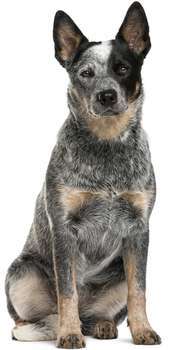
As the name suggests, these intelligent, medium size dogs were bred to be herders. They’re muscular and agile.
Good at running, this dog is alert and requires activity. Not a good choice of dogs for people that worship screens but great for someone that likes to mountain bike and run.
With only a few walks per day, the ACD will grow bored and restless, which is where mischief begins. Their stamina helps them herd cattle but also run with you on a trail.
Just be sure you’ve got that recall training down if you happen to bike next to a cattle ranch. Compared to other dogs, the ACD does well in tolerating heat.
This protective and loyal dog breed can be a little cold to strangers and is less eager to please, on average, in terms of obedience and trainability.
The Australian cattle dog’s work pedigree and its ruggedness and high energy, together with its loyalty illustrate well the danger of pushing a dog too far on the trails.
This dog will keep running with you even after it shouldn’t.
3. Border Collie:
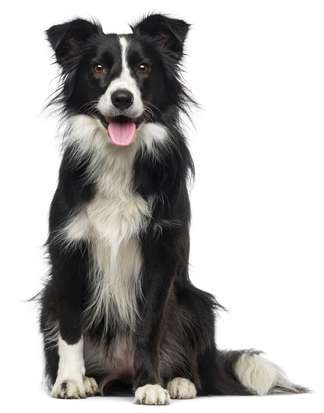
Another medium size herding dog, the border collie shares many traits with the Australian cattle dog. Full of energy and possessing great stamina, this breed is no lap dog.
It needs a job. Or lots of physical activity and games. Imagine a dog jumping in the air to catch a frisbee; insert the athletic border collie as an ideal dog for that picture.
The border collie, in fact, might be more dog than one person can handle — unless that person is very active and outdoor-oriented. These features should make it clear that this dog will thrive on running trails.
Frequently. If that sounds too demanding, just realize that many other activities will also make the dog happy.
You just can’t think that a few trips around the block each day, to supplement the occasional trail adventure, will be sufficient for this furry perpetual motion machine.
The border collie never got the memo about the five-day workweek. This breed needs stimulation, not sitting around the home waiting for its human.
In keeping with its advanced physical abilities, the border collie is also highly intelligent and very trainable.
The dog has a strong herding tendency and may try to herd animals, people, and bikes, yet they are distant with strangers.
Just keep an eye on your pooch at the trailhead parking lot, or you may end up with a herd of 12 unwanted riders going on a loop with you. Finally, the dog has good heat tolerance, relative to other dogs.
4. Weimaraner:
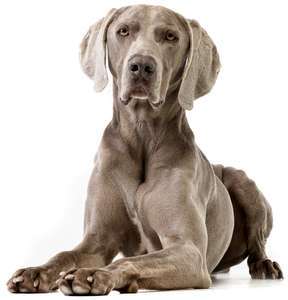
A fast dog that needs exercise, the Weimaraner is not an enjoyable housemate if it hasn’t had its time outdoors.
Bred to be hunting dogs, this large size breed with a short gray coat will chase anything resembling prey, including cats, squirrels, and birds.
They’ll also pursue bicyclists, so that bicyclist might as well be you on a trail. If carefully trained, the dog’s instinct for prey can be controlled.
But if poorly trained, going mountain biking with a Weimaraner could end up being more about redirecting your animal.
The dog is intelligent, obedient yet independent, and mentally active, so it should thrive on learning a new activity.
Great companions, Weimaraners will shadow you around. Adding to their appeal as a trail dog, Weimaraners don’t overheat easily.
Although Weimaraners might seem like pistons firing without end, these bundles of energy don’t know their limits and will run until their pads bleed. They need an attentive master.
Downside?
The Weimaraner has a reputation for being hyperactive, but if you read the descriptions of the other dogs on this list, you’ll see that doesn’t set them apart!
5. Labrador Retriever:
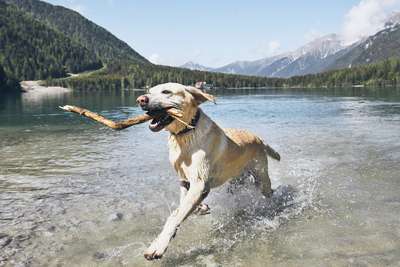
If there’s anyone out there who doesn’t like the outgoing Labrador, surely, they’ve been exiled from the community by now.
Like golden retrievers, this breed seemingly can do no wrong. Friendlier to strangers than some other dogs on this list, Labs also mix well with other dogs.
Not only do they make great family pets, but they were bred for work and sport. Go to your local park or beach and watch an agile, athletic Lab wear out its owner with a game of fetch.
Coming in chocolate, yellow, and black, the Lab, it will come as no surprise, is the most popular breed in the United States and England.
That it makes a great trail dog just adds to its luster. An intelligent and trainable dog, the Lab likes to please its master, which makes adding trail skills to its repertoire less challenging than with some other dogs.
Vigorous exercise will also help keep this dog’s weight down, as it eats like a teenage boy.
If you are a casual mountain biker and otherwise a couch potato, an eager Lab will need you to get a life. They need to get out and move.
This breed will keep moving to the point where they will overdo it; like other good trail dogs, Labs have a workaholic streak.
This dog can put up with the heat better than most dogs, but, as noted below, hot days are a poor choice for running any enthusiastic canine on trails.
How To Train Your Dog To Run With You (9 Advanced Tips):
1. Proper Attitude & Approach:
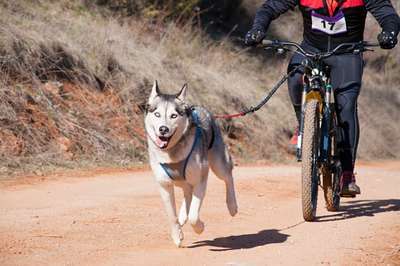
Slow & Steady Wins the Day
Humans usually think of trail riding involving skills that they need to learn. Because dogs don’t use bikes, and they seem to just be doing what they already do—running—it’s easy to overlook this.
Think of a dog like a novice rider.
Repetition & Consistency
Don’t be surprised if after a year of repeated practice your dog still needs some work.
Aside from mental learning, being consistent means a dog can develop fitness and you can limit the risk of injury.
Enter your text here...
2. Before Actually Riding:
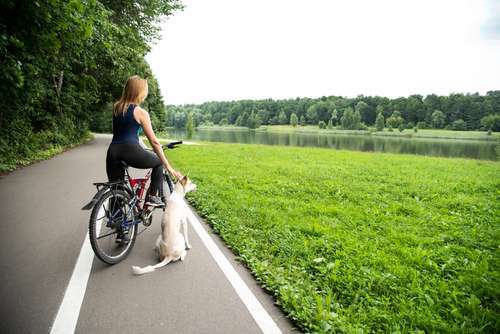
First Equation: Bike + Master + Dog – Trail
First, simply try to accustom your dog to the dog-bike-master threesome. Try to find a low-key situation where you can be on your bike with your dog.
If possible, find a park where your dog can go without a leash, with you alongside on your bike, or a path where you can ride slowly along with your dog on a leash.
If necessary, you might even do a few short walks while you push the bike instead of ride it.
If this step seems unnecessary and you just want to jump into it, then plan to go easier than you would otherwise on the trail the first couple times.
Next Equation: Master + Dog + Trail – Bike
Another good early step is to get the dog accustomed to the environment. Go to a hiking trail and practice there on foot.
Think of this process as step by step, with you introducing another piece each time. On the trail, practice things you’ll do while on the bike.
Many people interested in mountain biking with their dogs no doubt already does this, but they may not do it in a deliberate manner and as a stepping stone to somewhere else.
3. Commands:
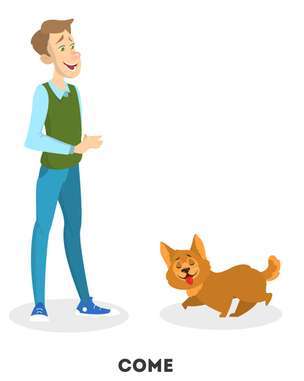
Come! Your dog needs a level of obedience to go on the trails. When your dog takes a wrong turn or gets too far ahead, you have to be able to call it back quickly.
Practice recall.
If your dog isn’t obedient about coming back to your call and you still want to go on trails, then practice more.
You have to be in charge, and you have to be ready for distractions, such as deer, smells, people, and other dogs.
If you’ve done some preparation and your dog still follows its instinct to chase every other family of squirrels, don’t give up.
You may just have to focus on training that one thing by itself.
You’ll have to monitor your dog more carefully at first, being ready to intervene with a call before the dog is running full speed after a skunk at a right angle to you.
Some Other Command Situations
You’ll want to develop a few simple commands for things like getting behind you; oncoming riders; road crossings; and about being passed.
4. Positioning:
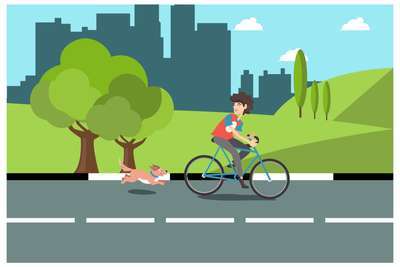
In Front or in Back?
Start by having the dog run in the back of you. More advanced is the dog that can run in front of you since there’s an increased chance of you landing on or running into the dog.
If the dog passes you, instead of thinking how much fun you’re having, remember that you’re training the dog.
Stop and reorder your dog in the back. Once the dog has that mastered, you can see how it does in front of you.
This obviously will take great care and will depend on your dog. You’ll want a command for when your dog gets too close to your front wheel, and you don’t want to issue it timidly. As dogs and front wheels don’t mix well.
Ultimately, your dog may do better behind you. Being able to see the dog at a safe distance in front, though, will allow more careful monitoring and freedom.
It may challenge your speed, fitness, and skills as well, as your dog may be a faster trail runner than you are a mountain biker!
Heel
Some trainers recommend never having the dog in front. Also, others recommend that having the dog next to you is the preferred position unless you’re in tight single-track.
Pace
Your dog has to learn to go at your pace, no matter the positioning.
5. Rewards:

Who’s a Good Girl?
Especially while training, rewarding your dog with positive reinforcement through treats is useful. Also important is a positive tone and comments when the dog stays.
For example, in the correct position and an assertive tone for corrections. These are things that most dog owners already do.
But the point is that you have to be more deliberate as you’re training the dog for something new.
6. The Right Trails at the Right Time:
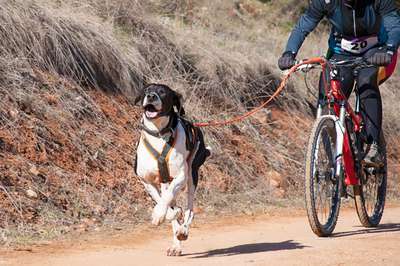
Sorry, Wrong Number.
Which of the following sounds like the best place to take your pooch:
If you said yes to all three... ok, you didn’t say yes to all three because ... you have common sense!
You said, “No, no, and no.” Treat the dog like you would a friend who wants to try the sport. Cross off the Lake Tahoe Rim Trail.
The softer the better; the fewer rocks the better
Dirt trails — not too hard and dry — will be best. Something easy for humans on bikes like a flat, rocky fire road won’t be great for a dog.
Rinse, Repeat
When to Ride
Avoid trails at peak times. Sixty cars in the trailhead parking lot probably aren’t the best recipe for four-legged fun.
Crowded trails mean there will be more potential hazards and distractions both for you and your dog. Reduce the number of hazardous variables as much as possible.
And remember, what isn’t a hazard when you ride with people, maybe a hazard when you’re with a dog.
7. Your Dog’s Limitations and Needs:
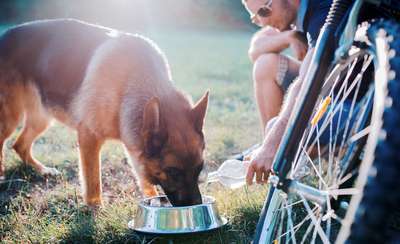
Distance
It’s easy to forget how short ten miles is on a bike but how long that is for a run. Just working up to five miles will likely take some time.
The first time you go out with your dog, an easy mile or two might be sufficient, depending on the terrain. Slowly increase your mountain biking with dog distance. See how your dog responds.
Fatigue
Your dog may not be able to go for as long as you, though it may run itself into the ground trying. Since your dog isn’t aware of its limits, it’s better to err on the side of doing too little.
Yes, you may wish to do that IMBA epic trail that’s mostly downhill, but your dog isn’t ready to go four more miles than usual. Especially as he has to keep running while you’re coasting on descents.
Your personal riding ambitions are not at the top of the list when you’re with your dog.
Weather
You might think of riding while it’s 88 and humid as not ideal but doable, but consider your furry companion who doesn’t have words for overheating.
You might think you’re finely attuned to your dog’s heat tolerance, but are you really when it comes to trail riding?
Dogs, due to breed, vary more than people in their heat tolerance. Figure out where to draw the line with your dog.
Build up gradually, getting poochie used to warmer temperatures and being highly aware of reasonable limits.
Hydration
Your dog doesn’t have a bottle cage or water bell but needs water breaks. Bring extra water for your dog, and carefully plan frequent breaks.
Those stops will force you to allow your dog to rest, to cool, and to let you better monitor their fatigue.
Energy
You have your shot blocks, gels, bars, and energy drink. Dogs also get hungry on the trail. Pack snacks.
Warning Signs
As we’re not always good about knowing our own limits. After all, many of us feel proud when we make ourselves suffer and overcome it successfully.
You’ll have to be extra sensitive about knowing your dog’s.
If you try to keep moving, but your dog tries to lie down because of tiredness, that’s a sign you’ve pushed too far. Give your dog a break, and possibly end the session.
8. Dog Gears:
Doggie Camelback
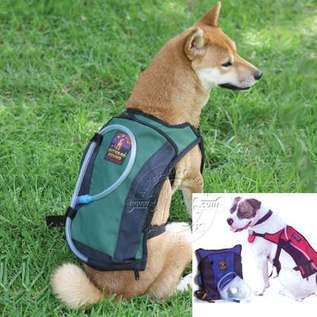
Via alphadogtoys.com
Have you trained your dog to drink from a water bottle? Probably not. So, you’ll need a collapsible dog bowl, such as the Outward Hound Port-a-Bowl.
Doggie Bike Shoes
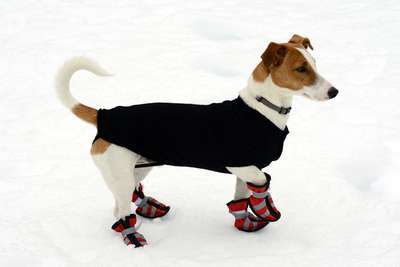
Most dogs don’t sport shoes around town, but you should worry more about a trail dog’s paws. Bounding on a rooted, rocky trail isn’t like walking on your living room carpet or manicured lawn.
You don’t want them tearing up their pads or nails. Build up your dog’s paws slowly. Always be careful about rocky terrain.
Inspect your dog’s paws after a ride. Give the paws time to recover. You might consider getting them booties to protect their feet, such as Grip Trex from Ruffwear.
Also, just like a rider who needs special skin balm for sore spots, a dog’s paws may need some type of post-ride treatment.
There are also paw treatments that are more preventative, such as Musher’s Secret and Tuf-Foot.
So You Want to Mush
If your dog does well in favorable winter weather, and you’re dying to get them next to you on your fat bike, you might consider paw covers, a jacket, and, again, salves like Musher’s Secret for paw protection.
Dos & Don’ts:

Be Attentive
Like going around with a child, you have to remember more than just yourself. I was riding once on a winding trail in very tall grass:
Without warning I was upon a dog and came inches from running it over before I slammed on the brakes and it darted off the trail, very spooked.
A few seconds later the owner, riding with a couple of friends, came in sight, oblivious to what almost happened.
This owner was probably distracted by companions and was not paying sufficient attention to changes in the trail.
Reduce Distractions
While your dog is getting the hang of trail running, don’t add in other distractions like riding with friends or inviting the girl or guy you’re trying to woo.
Keep Others in Mind
Your unleashed dog may surprise other riders. Also, some people are simply bothered by unleashed dogs.
Perhaps you think this is their problem, but if you’ve been bitten by an unleashed dog on a trail, as I have, or if you’re aware that dogs sometimes bite people, you might understand why.
You may know that your dog is friendly, but some people who are not monsters do not like dogs, are allergic to dogs, don’t like to be dripping with dog saliva, or have had bad experiences with dogs.
Leashes
Is it better to leash a dog to a bike?
This is about as good of an idea as it sounds. Unless you are up for a slow, slow ride, and have a slow, slow dog, and are riding a slow, slow trail, this scenario has so many possible bad endings.
For both you and your pet. It makes me cringe just thinking about it. Just don’t! (Bikejoring, which involves leashing dogs to a bike like sled dogs, is another matter but is beyond the scope of this guide).
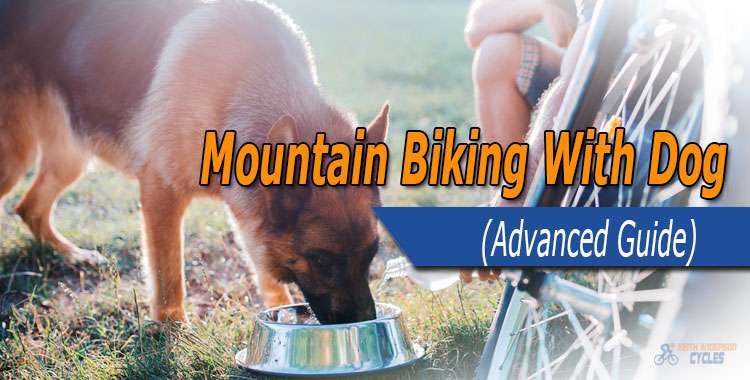
Trail Leash Rules
Not every trail system will allow dogs off leashes or will allow dogs at all. Be sure you know what the rules are for the trails you’re visiting.
Don’t assume that off-leash dogs in places that prohibit them don’t bother people. They probably do.
#2 Is No One’s #1
If there’s one way to annoy other riders with dogs on the trails, imagine a rider rolling along, a smile on her face, sending it over a drop, only to plop down in the middle of your dog’s #2 in the middle of the trail.
There’s a lot of room out in the woods for a dog to go—heck, you can even line up next to him and have another bonding moment—but if your dog does its business on the trail or at the trailhead, clean it up.
Identification
Updated tags, a good collar, and possibly a microchip or smart collar, are essential in case your dog becomes separated from you or something happens to you.
Although many will look at this point as obvious, we sometimes cut corners when we’re in a hurry or something slips our minds, and then it’s time to go. Do you really want to risk it?
Eating Before, After
Remember that old advice about not getting into a pool after a meal? In case you haven’t heard, that was a myth. But it still applies to your trail dog before hitting the trails.
Don’t feed a dog before a ride. Give the dog time to digest its previous meal. Bring food for your dog to consume 30 minutes after a ride.
The Bottom Line:
Look up one picture of a dog shredding on a mountain bike trail, bounding over a log, or making a small drop seem like nothing, and you’ll be convinced that you want a piece of it.
You get more exercise. Your dog gets more exercise. You both get more quality time together. What’s not to like?
Your turn: tell me what your favorite dog breed or tip for mountain biking with dog is.

Standard Poodles make excellent mountain biking partners too.
Great article about mountain biking with a dog.